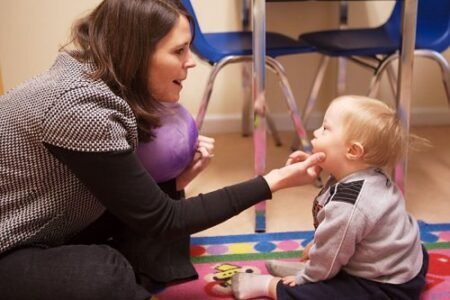Spina bifida
the definition
It is a birth defect in which the spine grows abnormally. It may affect the spinal cord and the nerves emanating from it and cause the child problems in movement and the excretory process, and it may not cause problems.
This disorder has degrees ranging from minor to major. simple may not have any effects, While large ones may cause:
– Weakness in the leg and thus a movement and walking disorder.
– The curvature of the spine and thus the disturbance of the position of the body.
Inability to control the bladder.
Congenital defects in the brain.
– Inflammation of the spinal cord if it is exposed.
Causes of spina bifida
Genetic reasons
Folic acid deficiency during pregnancy.
– The mother’s use of some medicines during pregnancy, such as Valproic acid.
Physiotherapy and occupational therapy for patients with spina bifida
A child with spina bifida undergoes surgery to prevent further problems. Then he undergoes a physiotherapy and rehabilitation program provided by the Egyptian Center for Physiotherapy at the highest level to help him develop his skills to be able to live independently.
Physiotherapy is very important to strengthen the leg and waist muscles in the postoperative period.
Among the most important axes of the physiotherapy program for patients with spina bifida at the Egyptian Center for Physiotherapy are:
– Sitting, balance and walking exercises to prevent joint stiffness and to strengthen muscles.
– A program to prevent pressure sores.
Providing orthopedic devices to relieve pressure on the leg.
– Developing a program to confront the possibility of strokes and paralysis of the legs and feet.
– Using medical splints to help move and walk
Functional electrical stimulation to aid movement
Down Syndrome
the definition
Down syndrome is a genetic condition that occurs when a child is born with 47 chromosomes instead of the normal 46. The extra chromosome, chromosome 21, causes a delay in brain development and a number of changes in physical features. It may lead to digestive and heart disorders.
Down syndrome symptoms
– flat face
– Small head
Short neck
Protruding tongue
Eyelids slanted upwards (eyelid clefts)
Two small ears
Weak muscle tension
– Two short, wide hands with one curl in the palm of the hand
Relatively short fingers and small hands and feet
Excessive flexibility
Tiny white spots on the colored part of the eye (iris) called Brushfield spots
Short length
Mild to moderate cognitive impairment.
– Speech delay
– Poor memory
Occupational and physical therapy for patients with Down syndrome
People with Down syndrome need to learn to practice the activities of their daily lives. Occupational therapists use a number of therapeutic techniques to do this task, such as sensory integration, vestibular stimulation, oral motor therapy, cognitive therapy, training in activities of daily living, and activity-focused neurodevelopmental therapy methods.
Sensory integration: To increase the awareness of people with Down syndrome about their body and the environment around them, and to provide an appropriate response to what is going on around them, in order to overcome problems such as frequent falls and the inability to grasp things or perform simple activities such as picking up food with the mouth.
Nerve stimulation: Through activities to strengthen nerves and muscles and treat nerve relaxation, These exercises enable them to perform independent motor skills such as sitting, standing and walking.
Coordination exercises: To activate coordination between the different joints such as the shoulder, wrist and hand for a more natural movement so that the person with Down syndrome can control the movement process.
Oral kinesthetic therapy: to strengthen the muscles of the tongue, cheek and lips, To control and not control the problems of drooling, And to facilitate the process of feeding and speaking.
Vestibular stimulation: To improve the child’s balance ability and thus provide a more natural movement process.

